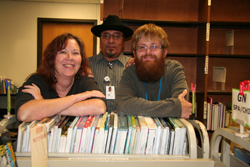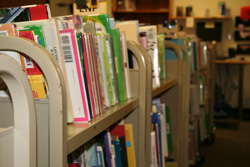Rock Beats
Check in room changes at the Library

Library staff members Elaine Turner, Joe Diaz and Eric Towler
With a collection of more than 200,000 items and a growing population of patrons, the Round Rock Public Library is a hive of activity, with books and materials being checked-out and returned everyday. Sometimes the Library will process as many as a 1,000 books an hour.
For Library staff, getting returned items back on the shelves and available for patrons as quickly as possible is crucial. Staff have worked the last several years to improve the check-in process and make it more efficient.
Out of sight
The first step involved creating a private space for the check-in process during the Library’s renovation. In the old set up, the check-in area was locate out in the open at the old circulation desk.
“We use carts to hold items and easily take them back to the appropriate shelves,” says David Sharp, library tech. “Before the renovation, the carts of items to be re-shelved were visible to patrons and so was the person processing the returned material. Each item has a security system that must be reactivated before it’s returned to the shelf.”
When lines got long at the circulation desk, patrons would often approach the person assigned to check-in for help, delaying the check-in process.
With the renovation, check-in is now done in a separate room that patrons don’t see but that is much smaller than the previous area.
“We knew we had to get the entire check-in procedure out of sight to avoid interruptions,” says David. “However, it was difficult to imagine operating with less space.”

To manage in the smaller area, the staff eliminated a large number of carts and added shelving to handle overflow items when the carts are full. The shelves take up much less space than the carts.
“The carts are each assigned to a specific range of library classification numbers and have a corresponding overflow shelf,” says David. “We have significantly fewer carts, which was a scary notion because it meant we would have to shelve items that much faster.”
With fewer carts, staff could arrange the cart room to allow for easy access to all the carts. The overflow shelves prevent the need to pile books on and around already full carts, making the room neater and safer.
Getting the picture
The Library has dozens of volunteers and many of them work in the check-in room shelving books and other materials. However, volunteers often work only a few hours a day so it was a challenge to ensure that everyone shelving materials knew which items had been waiting to be shelved for days and which had just been returned.
“Rarely do we assign someone to shelve for an entire day,” says David. “Usually, people work on it for a few hours so it can be hard to get a handle on what really needs to be shelved and what can wait.”
Staff wanted a way to quickly indicate the status of each cart so it would be easy to know what needed to be done first.
“We implemented a system to quickly and easily give everyone a big picture view of the entire room,” says David. “We have highly visible clips that indicate how long a cart has been sitting without being emptied. It’s an alert system that allows us to immediately see which carts are the most urgent. We want to turn over the whole room and not inadvertently allow some items to sit around for too long.”
Another clip indicates if a cart has items on an overflow shelf. There are also dividers that indicate if the items on the cart are in order or not.
“With this system, we are getting the books on the shelves faster and we can tell when we are starting to get behind at a glance,” says David. “It coordinates our efforts and cuts down on the number of hands touching a single item.”
